The history of the 15 puzzle.
Nederlandse versie.
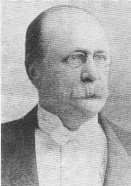 For
a long time it was not clear when the first slide puzzle was invented or
made. But it is was thought to be a well known fact that in 1878
Sam
Loyd, America's greatest puzzle-expert, "drove the whole world crazy"
(in his own words) with his newly "discovered"
14-15 puzzle. This was a variation on the "Puzzle of 15" which was made and
sold by the Embossing Company from New York about 10 years earlier. This
puzzle consisted of 15 numbered square pieces that could be slided around
in a square box that was big enough to contain 16 pieces. The pieces should
be placed at random in the box and you should sort the pieces in ascending
order without taking the pieces out of the box (so the only thing that is
allowed is to slide the pieces). Not every randomly placed pattern of pieces
can be sorted by just shuffling and Sam Loyd cleverly made use of this fact.
For
a long time it was not clear when the first slide puzzle was invented or
made. But it is was thought to be a well known fact that in 1878
Sam
Loyd, America's greatest puzzle-expert, "drove the whole world crazy"
(in his own words) with his newly "discovered"
14-15 puzzle. This was a variation on the "Puzzle of 15" which was made and
sold by the Embossing Company from New York about 10 years earlier. This
puzzle consisted of 15 numbered square pieces that could be slided around
in a square box that was big enough to contain 16 pieces. The pieces should
be placed at random in the box and you should sort the pieces in ascending
order without taking the pieces out of the box (so the only thing that is
allowed is to slide the pieces). Not every randomly placed pattern of pieces
can be sorted by just shuffling and Sam Loyd cleverly made use of this fact.
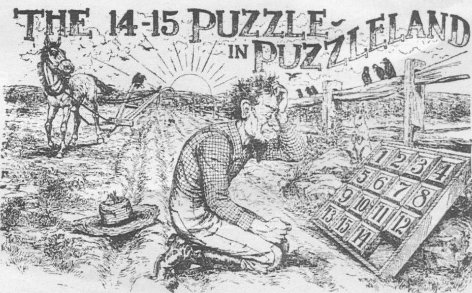 It was not
surprising that Sam drove the whole world crazy by his variation of the puzzle
of 15. The problem that he formulated was impossible to solve. When you bought
Sam's 14-15 puzzle the empty square was positioned bottom right. The pieces
were numbered in order from left to right and from top to bottom; only the
pieces numbered 14 and 15 were reversed. You should re-order the pieces so
all the pieces are in the correct position and the empty place should be
positioned bottom right again. For the correct solution a prize of 1000 dollar
was offered but Sam kept that money in his pocket. A slide puzzle with square
pieces can only be solved when the number of exchanges necessary to solve
the puzzle is even. The 14-15 puzzle attracted a world wide attention
that can only be compared with the
Rubik's Cube that
conquered the world 100 years later.
Ernö Rubik
was in fact inspired by the slide puzzle when he designed his famous cube
which can be seen as a 3 dimensional version of a slide puzzle.
It was not
surprising that Sam drove the whole world crazy by his variation of the puzzle
of 15. The problem that he formulated was impossible to solve. When you bought
Sam's 14-15 puzzle the empty square was positioned bottom right. The pieces
were numbered in order from left to right and from top to bottom; only the
pieces numbered 14 and 15 were reversed. You should re-order the pieces so
all the pieces are in the correct position and the empty place should be
positioned bottom right again. For the correct solution a prize of 1000 dollar
was offered but Sam kept that money in his pocket. A slide puzzle with square
pieces can only be solved when the number of exchanges necessary to solve
the puzzle is even. The 14-15 puzzle attracted a world wide attention
that can only be compared with the
Rubik's Cube that
conquered the world 100 years later.
Ernö Rubik
was in fact inspired by the slide puzzle when he designed his famous cube
which can be seen as a 3 dimensional version of a slide puzzle.
Quotation from the
Cyclopedia of Puzzles written
by Sam Loyd.
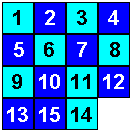 "The older inhabitants of Puzzleland will remember how in the
early seventies I drove the entire world crazy over a little box of movable
pieces which became known as the "14-15 Puzzle". The fifteen pieces were
arranged in the square box in regular order, only with the 14 and 15 reversed,
as shown in the figure. The puzzle consisted in moving the pieces about,
one at a time, so as to bring them back in the present position in every
respect except that the error in the 14 and 15 must be corrected. A price
of $1000, which was offered for the first correct solution to the problem
has never been claimed."
"The older inhabitants of Puzzleland will remember how in the
early seventies I drove the entire world crazy over a little box of movable
pieces which became known as the "14-15 Puzzle". The fifteen pieces were
arranged in the square box in regular order, only with the 14 and 15 reversed,
as shown in the figure. The puzzle consisted in moving the pieces about,
one at a time, so as to bring them back in the present position in every
respect except that the error in the 14 and 15 must be corrected. A price
of $1000, which was offered for the first correct solution to the problem
has never been claimed."
In 2006 Jerry Slocum and Dic Sonneveld published their book:
The 15 Puzzle. Many surprising
things were revealed in this book, including:
"Sam Loyd did not invent the 15 puzzle and had nothing to do with promoting
or popularizing it. The puzzle craze that was created by the 15 Puzzle began
in January 1880 in the US and in April in Europe. The craze ended by July
1880 and Sam Loyd’s first article about the puzzle was not published
until sixteen years later, January 1896. Loyd first claimed in 1891 that
he invented the puzzle, and he continued until his death a 20 year campaign
to falsely take credit for the puzzle. The actual inventor was Noyes Chapman,
the Postmaster of Canastota, New York, and he applied for a patent in March
1880."
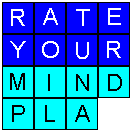 A clever variation of the 14-15 puzzle is the so called "Rate
your mind pal" puzzle that is shown beside. This puzzle seems impossible
to solve at first sight, certainly for someone who is familiar with the 14-15
puzzle. This puzzle can be solved however. Think hard ... and when you do
not find the answer ask me for a hint.
A clever variation of the 14-15 puzzle is the so called "Rate
your mind pal" puzzle that is shown beside. This puzzle seems impossible
to solve at first sight, certainly for someone who is familiar with the 14-15
puzzle. This puzzle can be solved however. Think hard ... and when you do
not find the answer ask me for a hint.
Since the famous Sam Loyd's slide puzzle thousands of different slide puzzles
are made. Most of them formed a picture when correctly solved. A slide puzzle
with the companies logo was used by a lot of companies as a small gift for
their relations. Click here to see some
examples. Around 1910 the idea to use rectangular pieces came up. These
puzzles are most of the time much more difficult to solve than puzzles with
only square pieces. For more information on slide puzzles you can consult
Edward Hordern's
book
Sliding
Piece Puzzles published by the Oxford University Press in 1986. A detailed
discussion of the puzzle of 15 and others is given in
Automated Reasoning:
Introduction and Applications, by Larry Wos, Ross Overbeek, Ewing Lusk,
and Jim Boyle published by McGraw-Hill.
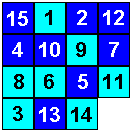 A nice variation of the basic slide puzzle is a slide puzzle
with 15 pieces numbered form 0(empty) to 15 (inclusive) with the instruction
to slide the pieces so the sum of all rows and the sum of all columns
and the sum of the diagonals equals 30. Such an ordering is called
a magic
square.
A nice variation of the basic slide puzzle is a slide puzzle
with 15 pieces numbered form 0(empty) to 15 (inclusive) with the instruction
to slide the pieces so the sum of all rows and the sum of all columns
and the sum of the diagonals equals 30. Such an ordering is called
a magic
square.
 For
a long time it was not clear when the first slide puzzle was invented or
made. But it is was thought to be a well known fact that in 1878
Sam
Loyd, America's greatest puzzle-expert, "drove the whole world crazy"
(in his own words) with his newly "discovered"
14-15 puzzle. This was a variation on the "Puzzle of 15" which was made and
sold by the Embossing Company from New York about 10 years earlier. This
puzzle consisted of 15 numbered square pieces that could be slided around
in a square box that was big enough to contain 16 pieces. The pieces should
be placed at random in the box and you should sort the pieces in ascending
order without taking the pieces out of the box (so the only thing that is
allowed is to slide the pieces). Not every randomly placed pattern of pieces
can be sorted by just shuffling and Sam Loyd cleverly made use of this fact.
For
a long time it was not clear when the first slide puzzle was invented or
made. But it is was thought to be a well known fact that in 1878
Sam
Loyd, America's greatest puzzle-expert, "drove the whole world crazy"
(in his own words) with his newly "discovered"
14-15 puzzle. This was a variation on the "Puzzle of 15" which was made and
sold by the Embossing Company from New York about 10 years earlier. This
puzzle consisted of 15 numbered square pieces that could be slided around
in a square box that was big enough to contain 16 pieces. The pieces should
be placed at random in the box and you should sort the pieces in ascending
order without taking the pieces out of the box (so the only thing that is
allowed is to slide the pieces). Not every randomly placed pattern of pieces
can be sorted by just shuffling and Sam Loyd cleverly made use of this fact.
 It was not
surprising that Sam drove the whole world crazy by his variation of the puzzle
of 15. The problem that he formulated was impossible to solve. When you bought
Sam's 14-15 puzzle the empty square was positioned bottom right. The pieces
were numbered in order from left to right and from top to bottom; only the
pieces numbered 14 and 15 were reversed. You should re-order the pieces so
all the pieces are in the correct position and the empty place should be
positioned bottom right again. For the correct solution a prize of 1000 dollar
was offered but Sam kept that money in his pocket. A slide puzzle with square
pieces can only be solved when the number of exchanges necessary to solve
the puzzle is even. The 14-15 puzzle attracted a world wide attention
that can only be compared with the
It was not
surprising that Sam drove the whole world crazy by his variation of the puzzle
of 15. The problem that he formulated was impossible to solve. When you bought
Sam's 14-15 puzzle the empty square was positioned bottom right. The pieces
were numbered in order from left to right and from top to bottom; only the
pieces numbered 14 and 15 were reversed. You should re-order the pieces so
all the pieces are in the correct position and the empty place should be
positioned bottom right again. For the correct solution a prize of 1000 dollar
was offered but Sam kept that money in his pocket. A slide puzzle with square
pieces can only be solved when the number of exchanges necessary to solve
the puzzle is even. The 14-15 puzzle attracted a world wide attention
that can only be compared with the
 "The older inhabitants of Puzzleland will remember how in the
early seventies I drove the entire world crazy over a little box of movable
pieces which became known as the "14-15 Puzzle". The fifteen pieces were
arranged in the square box in regular order, only with the 14 and 15 reversed,
as shown in the figure. The puzzle consisted in moving the pieces about,
one at a time, so as to bring them back in the present position in every
respect except that the error in the 14 and 15 must be corrected. A price
of $1000, which was offered for the first correct solution to the problem
has never been claimed."
"The older inhabitants of Puzzleland will remember how in the
early seventies I drove the entire world crazy over a little box of movable
pieces which became known as the "14-15 Puzzle". The fifteen pieces were
arranged in the square box in regular order, only with the 14 and 15 reversed,
as shown in the figure. The puzzle consisted in moving the pieces about,
one at a time, so as to bring them back in the present position in every
respect except that the error in the 14 and 15 must be corrected. A price
of $1000, which was offered for the first correct solution to the problem
has never been claimed."
 A clever variation of the 14-15 puzzle is the so called "Rate
your mind pal" puzzle that is shown beside. This puzzle seems impossible
to solve at first sight, certainly for someone who is familiar with the 14-15
puzzle. This puzzle can be solved however. Think hard ... and when you do
not find the answer
A clever variation of the 14-15 puzzle is the so called "Rate
your mind pal" puzzle that is shown beside. This puzzle seems impossible
to solve at first sight, certainly for someone who is familiar with the 14-15
puzzle. This puzzle can be solved however. Think hard ... and when you do
not find the answer  A nice variation of the basic slide puzzle is a slide puzzle
with 15 pieces numbered form 0(empty) to 15 (inclusive) with the instruction
to slide the pieces so the sum of all rows and the sum of all columns
and the sum of the diagonals equals 30. Such an ordering is called
a
A nice variation of the basic slide puzzle is a slide puzzle
with 15 pieces numbered form 0(empty) to 15 (inclusive) with the instruction
to slide the pieces so the sum of all rows and the sum of all columns
and the sum of the diagonals equals 30. Such an ordering is called
a